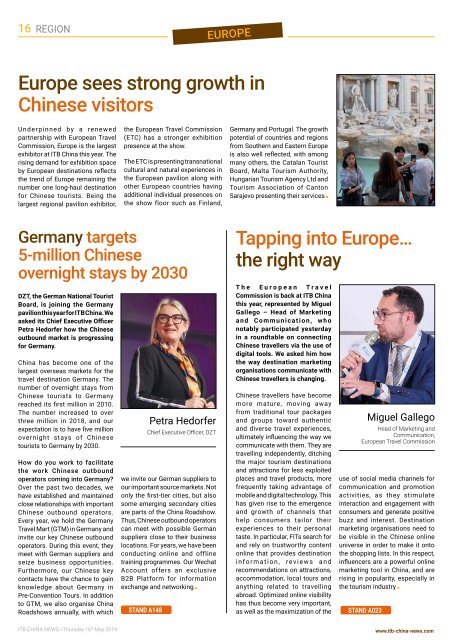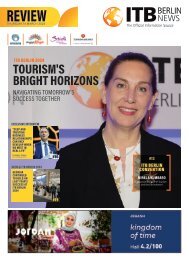ITB China News 2019 - Day 2 Edition
Create successful ePaper yourself
Turn your PDF publications into a flip-book with our unique Google optimized e-Paper software.
16<br />
REGION<br />
EUROPE<br />
Europe sees strong growth in<br />
Chinese visitors<br />
Underpinned by a renewed<br />
partnership with European Travel<br />
Commission, Europe is the largest<br />
exhibitor at <strong>ITB</strong> <strong>China</strong> this year. The<br />
rising demand for exhibition space<br />
by European destinations reflects<br />
the trend of Europe remaining the<br />
number one long-haul destination<br />
for Chinese tourists. Being the<br />
largest regional pavilion exhibitor,<br />
the European Travel Commission<br />
(ETC) has a stronger exhibition<br />
presence at the show.<br />
The ETC is presenting transnational<br />
cultural and natural experiences in<br />
the European pavilion along with<br />
other European countries having<br />
additional individual presences on<br />
the show floor such as Finland,<br />
Germany and Portugal. The growth<br />
potential of countries and regions<br />
from Southern and Eastern Europe<br />
is also well reflected, with among<br />
many others, the Catalan Tourist<br />
Board, Malta Tourism Authority,<br />
Hungarian Tourism Agency Ltd and<br />
Tourism Association of Canton<br />
Sarajevo presenting their services<br />
Germany targets<br />
5-million Chinese<br />
overnight stays by 2030<br />
DZT, the German National Tourist<br />
Board, is joining the Germany<br />
pavilion this year for <strong>ITB</strong> <strong>China</strong>. We<br />
asked its Chief Executive Officer<br />
Petra Hedorfer how the Chinese<br />
outbound market is progressing<br />
for Germany.<br />
<strong>China</strong> has become one of the<br />
largest overseas markets for the<br />
travel destination Germany. The<br />
number of overnight stays from<br />
Chinese tourists to Germany<br />
reached its first million in 2010.<br />
The number increased to over<br />
three million in 2018, and our<br />
expectation is to have five million<br />
overnight stays of Chinese<br />
tourists to Germany by 2030.<br />
How do you work to facilitate<br />
the work Chinese outbound<br />
operators coming into Germany?<br />
Over the past two decades, we<br />
have established and maintained<br />
close relationships with important<br />
Chinese outbound operators.<br />
Every year, we hold the Germany<br />
Travel Mart (GTM) in Germany and<br />
invite our key Chinese outbound<br />
operators. During this event, they<br />
meet with German suppliers and<br />
seize business opportunities.<br />
Furthermore, our Chinese key<br />
contacts have the chance to gain<br />
knowledge about Germany in<br />
Pre-Convention Tours. In addition<br />
to GTM, we also organise <strong>China</strong><br />
Roadshows annually, with which<br />
we invite our German suppliers to<br />
our important source markets. Not<br />
only the first-tier cities, but also<br />
some emerging secondary cities<br />
are parts of the <strong>China</strong> Roadshow.<br />
Thus, Chinese outbound operators<br />
can meet with possible German<br />
suppliers close to their business<br />
locations. For years, we have been<br />
conducting online and offline<br />
training programmes. Our Wechat<br />
Account offers an exclusive<br />
B2B Platform for information<br />
exchange and networking<br />
STAND A148<br />
Petra Hedorfer<br />
Chief Executive Officer, DZT<br />
Tapping into Europe…<br />
the right way<br />
The European Travel<br />
Commission is back at <strong>ITB</strong> <strong>China</strong><br />
this year, represented by Miguel<br />
Gallego – Head of Marketing<br />
and Communication, who<br />
notably participated yesterday<br />
in a roundtable on connecting<br />
Chinese travellers via the use of<br />
digital tools. We asked him how<br />
the way destination marketing<br />
organisations communicate with<br />
Chinese travellers is changing.<br />
Chinese travellers have become<br />
more mature, moving away<br />
from traditional tour packages<br />
and groups toward authentic<br />
and diverse travel experiences,<br />
ultimately influencing the way we<br />
communicate with them. They are<br />
travelling independently, ditching<br />
the major tourism destinations<br />
and attractions for less exploited<br />
places and travel products, more<br />
frequently taking advantage of<br />
mobile and digital technology. This<br />
has given rise to the emergence<br />
and growth of channels that<br />
help consumers tailor their<br />
experiences to their personal<br />
taste. In particular, FITs search for<br />
and rely on trustworthy content<br />
online that provides destination<br />
information, reviews and<br />
recommendations on attractions,<br />
accommodation, local tours and<br />
anything related to travelling<br />
abroad. Optimized online visibility<br />
has thus become very important,<br />
as well as the maximization of the<br />
use of social media channels for<br />
communication and promotion<br />
activities, as they stimulate<br />
interaction and engagement with<br />
consumers and generate positive<br />
buzz and interest. Destination<br />
marketing organisations need to<br />
be visible in the Chinese online<br />
universe in order to make it onto<br />
the shopping lists. In this respect,<br />
influencers are a powerful online<br />
marketing tool in <strong>China</strong>, and are<br />
rising in popularity, especially in<br />
the tourism industry<br />
STAND A023<br />
Miguel Gallego<br />
Head of Marketing and<br />
Communication,<br />
European Travel Commission<br />
<strong>ITB</strong> CHINA NEWS • Thursday 16 th May <strong>2019</strong><br />
www.itb-china-news.com

















